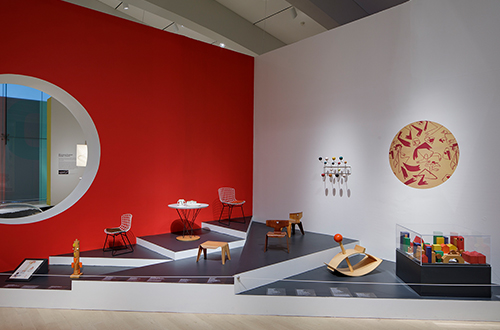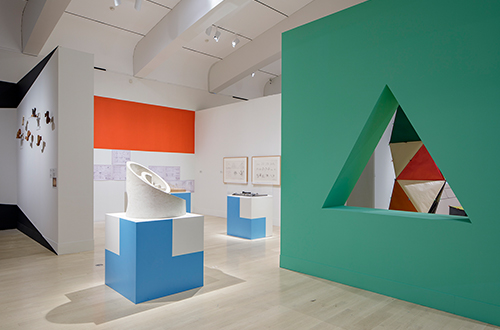What Is the Best Paint for Art Gallery Walls
Exhibition designers from four art museums share their secrets for choosing pigment colors to make artwork shine.
Approximately 300,000 people visit the Milwaukee Fine art Museum every twelvemonth. Plenty of them inquire about the pigment colors used on the gallery walls that the museum sends them straight to the closest Sherwin-Williams shop (at 807 Due east. Brady St.), which is ready to share the exact specifications for every infinite. "People really pay attention to those colors and say, 'I'm going to imitate that,'" says David Russick, the museum's exhibition designer.
The interest is sincere, but is the approach that simple? STIR tapped Russick and exhibition designers from three other leading art museums — all Sherwin-Williams customers — for the inside scoop on their color and finish preferences, procedure and more than.
The contempo exhibition Serious Play: Design in Midcentury America at the Milwaukee Art Museum explored the projects of more than than forty designers who advocated for playfulness and whimsy — calling for a backdrop of custom Sherwin-Williams colors that did the same.
Color and Saturation
The Milwaukee Art Museum's Russick likens colour to sound volume. "Information technology's literally infinite," he says. "You tin can shout, y'all can whisper and you lot can practise every decibel level in between." What he chooses, frequently asking a Sherwin-Williams store to tint a color slightly lighter or darker to get custom, reinforces what the fine art is attempting to share. "If it's done properly, I think color becomes a glue — a binding chemical element — that brings the works together," he says. Lawrence Waung, the chief exhibition designer at the North Carolina Museum of Art (NCMA) in Raleigh, agrees and acknowledges the importance of paint colour in creating a connection. "We're always trying to employ color that will assist ascertain the special relationship nosotros want the viewer to have with the artwork," he says. "It's more psychological than physical."
For a Georgia O'Keefe exhibition at the NCMA, that meant Vesper Violet SW 6542 (187-C3), Daydream 6541 (187-C2) and Superwhite SW 6995. (Notation: Superwhite SW 6995 is a retired colour that is still available via custom tinting.) "We're constantly looking for colors that recede from view so that they don't get in forepart of our objects," Waung says.
Paler, quieter colors aren't always the reply. In the past, popular belief might have placed 19th-century impressionist paintings, for case, confronting cotton wool candy, baby blue or light green walls, says John Jackson, an exhibition designer at the Nelson-Atkins Museum of Art in Kansas Urban center, Missouri. "Merely the tendency lately has been to go with darker, richer colors to brand the paintings themselves have a whiter value so that they pop and come off the walls instead of blending in," he says.
For Jackson, the same approach applies to creating backdrops for decorative arts and sculptural objects. A special exhibition on view at the museum through May 2020, Teachers of Enlightenment: Traditions in Tibetan Buddhism, includes bronze sculptural pieces that resemble a navy color. They stand up out beautifully against the ruddy Tanager SW 6601 (107-C6) Jackson chose for the walls.
Just exhibition designers walk a fine line between choosing resonant colors — and choosing colors that stand out too much. "We have a fairly well-known collection of Dutch paintings that tend to be really dark with a lot of glazing, and when they're up against a white wall, it takes a while for your eyes to adjust," Waung says. "Then, we're mindful of doing something that's easier on the eyes."
That said, for more modern and contemporary art, exhibition designers often discover white works best. For the Nelson-Atkins Museum of Fine art, it's Pure White SW 7005 (255-C1); for the NCMA, it'due south Superwhite SW 6995; for the Milwaukee Fine art Museum, it's a custom white.
Custom Sherwin-Williams colors complement bold geometric shapes in the Milwaukee Art Museum's recent Serious Play exhibition.
Cease
Exhibition designers recommend a non-reflective flat finish, which prevents glare from runway and natural lighting. Jackson, however, sometimes prefers satin or eg-shel finishes, which are traditionally easier to continue clean. "If we employ flat, we tin have scuffmarks and handprints on the wall within hours," he says. (Note: Both Sherwin-Williams Emerald ® and Duration Home ® paints now come up in cleanable flat finishes.)
The Milwaukee Fine art Museum'south 2018 exhibition of works by artist Winslow Homer — all influenced by time he spent in remote coastal England — chosen for a custom blue backdrop.
An Iterative Process
Choosing the best paint color for a gallery wall tends to be an iterative process, the exhibition designers say.
"Nosotros often commencement by taking a simple colour cycle and looking at what's on the opposite end," Jackson says. He then applies that principle to a fan deck of swatches, zeroes in on the top 3 or four paint colors, and has them painted on two-past-4-foot foam cadre boards to hold upwardly confronting the art.
Hans Schmitt-Matzen, the assistant director of internal affairs at the Frist Art Museum in Nashville, Tennessee, does the same. "We often go back and along a couple of times to make sure information technology's just right," he says. "We never, ever pick a color without doing a colour sample to make sure information technology's correct. I highly recommend investing in a quart of paint before making a commitment to paint the whole room or wall."
Custom purple and blue come together in the Milwaukee Art Museum's recent exhibition of painter Winslow Homer's works.
Photos: John R. Glembin, Milwaukee Art Museum
Source: https://www.sherwin-williams.com/architects-specifiers-designers/inspiration/sw-backdrop-for-art

0 Response to "What Is the Best Paint for Art Gallery Walls"
Post a Comment